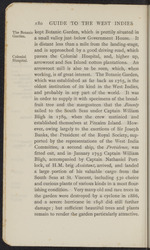| 1 |
 |
“...interest. The Botanic Garden,
which was established as far back as 1765, is the
oldest institution of its kind in the West Indies,
and probably in any part of the world. It was
in order to supply it with specimens of the bread-
fruit tree and the mangosteen that the Bounty
sailed to the South Seas under Captain William
Bligh in 1789, when the crew mutinied and
established themselves at Pitcairn Island. How-
ever, owing largely to the exertions of Sir Joseph
Banks, the President of the Royal Society, sup-
ported by the representations of the West India
Committee, a second ship, the Providence, was
fitted out, and in January 1793 Captain William
Bligh, accompanied by Captain Nathaniel Port-
lock, of H.M. brig Assistant, arrived, and landed
a large portion of his valuable cargo from the
South Seas at St. Vincent, including 530 choice
and curious plants of various kinds in a most flour-
ishing condition. Very many old and rare trees in
the garden were destroyed by a cyclone in 1886,
and a severe hurricane...”
|
|
| 2 |
 |
“...is comparatively easy to
ascend, but, until 1878, the smaller Piton was un-
conquered by man. In that year, however, a Mr.
Lompré succeeded in gaining its summit, and,
shortly after, it was ascended by Chief Justice
Carrington and a party. Local tradition relates
that four English sailors once tried to climb the
highest Piton. They were watched from below
through a telescope, and one after the other dis-
appeared. Half-way up one fell, a little higher
another dropped, and then a third. It was sup-
posed that they fell victims to the deadly Fer-de-
lance snake, which once infested St. Lucia.
nilond BetWeen St‘ Lucia and Martinique there stands
Rock. an isolated rock, which rises sheer out of the
water off the south coast of the latter island. No
Englishman can gaze upon it without a feeling of
pride, for it is the historic Diamond Rock which,
during the war with France in 1803, was garri-
soned for sixteen weeks by the crew of a British
cruiser, who, by means of ropes, hauled their guns...”
|
|
